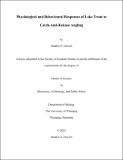| dc.contributor.author | Howell, Bradley E. | |
| dc.date.accessioned | 2023-08-16T20:21:05Z | |
| dc.date.available | 2023-08-16T20:21:05Z | |
| dc.date.issued | 2023-07-13 | |
| dc.identifier.citation | Howell, Bradley E. Physiological and Behavioural Responses of Lake Trout to Catch-And-Release Angling; A thesis submitted to the Faculty of Graduate Studies in partial fulfillment of the requirements for the degree of Master of Science in Bioscience, Technology, and Public Policy, Department of Biology, The University of Winnipeg. Winnipeg, Manitoba, Canada: University of Winnipeg, 2023. DOI: 10.36939/ir.202308161516. | en_US |
| dc.identifier.uri | https://hdl.handle.net/10680/2099 | |
| dc.description.abstract | Lake trout (Salvelinus namaycush), like many other native fishes in North America are a popular species typically targeted for recreational angling. Catch-and-release angling (C&R) relies on the assumption of high fish survival following release and is considered an effective way to preserve wild stocks of fish. Salmonids and other related species are susceptible to recreational angling, which can induce stress during different parts of the process (e.g., line fighting and air exposure). Other factors can impact fish health (e.g., water temperature and hooking location) and potentially lead to delayed mortality. In this thesis, I present empirical research where I used reflex impairment, physiology, and overall activity to assess the robustness of lake trout to C&R across seasons and time scales. During ice angling, lake trout experienced signs of reflex and physiological impairment up to 6 h and a high mortality rate. A key finding was that lake trout may exhibit pressure-related injuries in cooler water temperatures despite being physostomous. During open water angling, lake trout experienced barotrauma, reflex impairment, and physiological impairment immediately upon capture and 0.5 h post-angling. The addition of post-release activity monitoring via tri-axial accelerometry showed that lake trout rapidly swim to depth and exhibit reduced activity for the first 14 min after release. Collectively, I demonstrate that using multiple metrics of assessing angling-related impairment (i.e., both external and internal metrics) is necessary and future studies should not rely on one or few indices. The work presented here provides new information regarding context-specific aspects of C&R and is useful for recreational fisheries management. | en_US |
| dc.description.sponsorship | Manitoba Fish and Wildlife Enhancement Fund (#FES20-006), Natural Sciences and Engineering Research Council (NSERC) Alliance Grant (ALLRP 562034-21), Canadian Northern Scientific Training Program (NSTP), The University of Winnipeg. | en_US |
| dc.language.iso | en | en_US |
| dc.publisher | University of Winnipeg | en_US |
| dc.rights | info:eu-repo/semantics/openAccess | en_US |
| dc.subject | Lake trout -- Physiology | en_US |
| dc.subject | Stress | en_US |
| dc.subject | Reflexes | en_US |
| dc.subject | Locomotor activity | en_US |
| dc.subject | Mortality | en_US |
| dc.subject | Barotrauma | en_US |
| dc.title | Physiological and Behavioural Responses of Lake Trout to Catch-And-Release Angling | en_US |
| dc.type | Thesis | en_US |
| dc.description.degree | Master of Science in Bioscience, Technology, and Public Policy | en_US |
| dc.publisher.grantor | University of Winnipeg | en_US |
| dc.identifier.doi | 10.36939/ir.202308161516 | en_US |
| thesis.degree.discipline | Biology | |
| thesis.degree.level | masters | |
| thesis.degree.name | Master of Science in Bioscience, Technology, and Public Policy | |
| thesis.degree.grantor | University of Winnipeg | |

